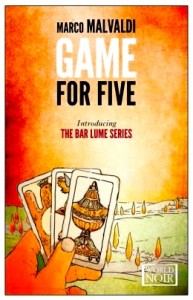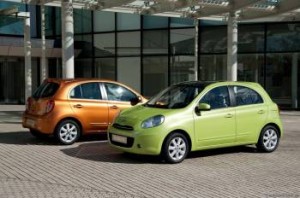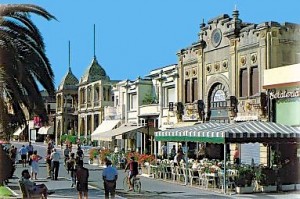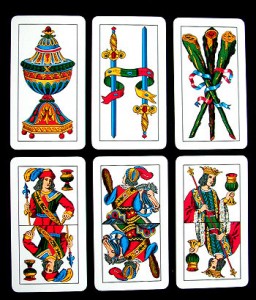“When you start swaying on your legs, when you light another cigarette to kill five more minutes even though your throat is stinging and your mouth is so furred up you feel like you’ve eaten a tarpaulin, and then the others also light cigarettes and linger a while longer – when all that happens, then it really is time to go home to bed.” – from the Prologue, as three young men meet after four a.m. and then decide to go home.
 Valuing the idea that “keeping it simple” is important to the success of mystery stories, author Marco Malvaldi draws deliberate parallels between the conclusion in Leonardo Sciascia’s, A Simple Story, in which the main character suddenly finds “where the light switch is,” the clue that allows him to solve the entire mystery, and the final resolution in Malvaldi’s own Game for Five, as bartender Massimo Viviani suddenly solves the murder of a young woman. Simple deductions have been the key to his success. This short, uncomplicated, and often very funny novel depends for its success on more than the mystery itself, however. Quirky characters, three of them in their mid-seventies and one in his eighties, gather regularly at Massimo’s Bar Lume to pass the time playing heated games of briscola and gossiping about everyone and everything in their coastal community outside of Pisa. Massimo, the thirty-ish bartender/owner of the Bar Lume, humors these characters, often joining in their card game as a fifth player when times are slow, and chatting and sharing their lives with them, valuing their commentary on all subjects and offering his own, sometimes contrary, observations to keep things lively.
Valuing the idea that “keeping it simple” is important to the success of mystery stories, author Marco Malvaldi draws deliberate parallels between the conclusion in Leonardo Sciascia’s, A Simple Story, in which the main character suddenly finds “where the light switch is,” the clue that allows him to solve the entire mystery, and the final resolution in Malvaldi’s own Game for Five, as bartender Massimo Viviani suddenly solves the murder of a young woman. Simple deductions have been the key to his success. This short, uncomplicated, and often very funny novel depends for its success on more than the mystery itself, however. Quirky characters, three of them in their mid-seventies and one in his eighties, gather regularly at Massimo’s Bar Lume to pass the time playing heated games of briscola and gossiping about everyone and everything in their coastal community outside of Pisa. Massimo, the thirty-ish bartender/owner of the Bar Lume, humors these characters, often joining in their card game as a fifth player when times are slow, and chatting and sharing their lives with them, valuing their commentary on all subjects and offering his own, sometimes contrary, observations to keep things lively.
Massimo, whose point of view drives this story, finds himself drawn unexpectedly into a murder mystery, which makes him the center of much interest among the patrons of his bar and in the community at large. Late one long night, after four in the morning, as Massimo has been cleaning up his bar, three young men, so inebriated they can hardly walk, are standing beside a green Nissan Micra across the street, with two of them trying to talk the drunkest youth, the owner of the car, out of driving home. The young man insists on driving off, but half a mile from the bar where Massimo is working, the youth pulls off the road to relieve himself in a trash barrel. When he discovers that the barrel is “occupied” by the dead body of a beautiful young woman, he also learns that his cell phone is dead. Returning to Massimo’s bar to call the police, he is so drunk he is unable to make himself understood, and it is Massimo who accompanies him back to the woods and summons the police, thereby involving himself in this murder mystery.

The young man who eventually discovers a woman's body in a trash can is standing beside his green Nissan Micra, like this one, at 4:00 a.m., across from Massimo's bar, before leaving for home in a drunken stupor.
Massimo’s Bar Lume has been used for years as the regular card-playing hangout of a group of elderly men, who also serve as Massimo’s sounding board when he becomes increasingly convinced that the police, acting too quickly, have detained the wrong man for the murder. Ampelio, age eighty-two, is a retired railroader and “uncontested winner of [a] cursing competition” held unofficially at a local festival each year. Aldo is the owner of a relatively upscale restaurant; Gino is a retired postal worker; and Pilade, who “apart from being ill-mannered [and] a pain in the butt,” has been employed at the town hall. Because of their former jobs and their naturally gregarious natures, they know just about everyone in town, and they become conduits for information, bringing rumor and gossip to Massimo as he works on freeing the young man he believes innocent, and, unfortunately, conveying every scrap of information they learn from Massimo to the rest of the town. Scenes from their ferocious games of briscola are so lively and so full of natural dialogue, as conveyed through the ironic and sometimes hilarious point of view of Massimo, that the reader feels as if they are all people s/he knows and enjoys.
At times during the action of the novel, the static setting of the bar and the teasing back-and-forth of the characters, as they sort things out and convey their lives and attitudes through their conversations, make the novel feel like a play, with much of the action taking place off-stage and Massimo acting as the Stage Director. Often farcical, the action that does occur features some typical, often stereotyped characters – arrogant but clumsy police; a sensitive local doctor; a bouncer with muscles for brains; teenagers experimenting with sex, drugs, and alcohol; a society woman more interested in upward mobility than in her family; and the hard-working and honest, but single, Massimo, who has been disappointed in love. As complications arise in the investigation of the murder and the focus shifts among a series of suspects, Massimo becomes convinced that he knows who the guilty party is, but, he says, “I feel like the main character in…Sciascia’s A Simple Story, when his superior tells him where the light switch is…and he understands the whole thing, who the murderer is and how he did it. And like him I don’t know who…to tell.”

Pineta, where the action takes place, is described as being a coastal village near Pisa, newly gentrified, perhaps similar to Viareggio, here. Note the outdoor bar/cafe.
The solution to the mystery, which is delayed till the very end, is almost unimportant to the fun of the book. It is Massimo’s point of view which carries the novel – his comments about life in the town, about its people, and about Italy, reflect his good nature and his never-failing sense of humor, making this novel closer to comedy than to noir. The author’s descriptions and his dialogue are often unique: At one point, Massimo asks that Tiziana, his busy assistant, come in to cover for him during her time off, giving her a set of instructions to which she answers: “Yes, Bwana. Do you also have instructions about the cotton harvest?” The character of another person is conveyed through this description: “[As a child], many questions had come into his mind, such as ‘How long will it take this lizard to die after I’ve cut off its head?” and “Why don’t cats fall on their feet if you tie a weight to their tails?” And when Massimo eventually decides to ask the four old men if he can play cards with them, “he wondered if thinking that playing cards with four old geezers mightn’t be a symptom of something strange about him, but he immediately dismissed the thought. Can I at least decide what I like? he thought, and focused his attention on the High Priest who was about to open the gates of the Temple to him.” Short, snappy, filled with humor, and great fun, this is a light entertainment, perfect for a change of pace or for summer reading.
ALSO by Malvaldi: THREE-CARD MONTE
Photos, in order: The author’s photo may be found on http://www.festivaletteratura.it
The green Nissan Micra, like the car owned by the young man who discovers the woman’s body in the trash can, appears on http://www.caradvice.com.au
The unique briscola cards are shown on http://www.seeyouinitaly.com/
Viareggio, perhaps similar to Pineta, the “coastal community near Pisa” which has recently become gentrified, may be seen here: http://italyholidays.wordpress.com/
ARC: Europa Editions


